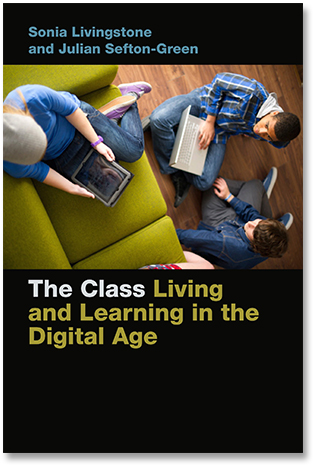The Class, book review: Talking about their generation


The Class: Living and Learning in the Digital Age • by Sonia Livingstone and Julian Sefton-Green • NYU Press • 356 pages • ISBN: 978-1-4798-2424-3 • £18.99/$27 (paperback)
It's easy to forget -- particularly at the moment, with both government and media fretting about age verification and young people's access to online pornography -- that although today's kids are growing up in 'the digital future', they are also growing up surrounded by many other influences. Schools, friends, family, local areas, other media, and events in the world at large all play their part. Sonia Livingstone, a professor at the LSE who for the last few years has run the Parenting for a Digital Future project (for which I have written blog postings), has long shown herself to be one of the few sane researchers on these sorts of issues in this country, as interested in children's rights as she is in child protection.
To write The Class: Living and Learning in the Digital Age, Livingstone and colleague Julian Sefton-Green spent the 2011-2012 school year observing and interacting with a class of 28 Year 9 teenagers -- that is, 13 and 14-year-olds. The group was demographically diverse -- its gender ratio skewed 2:1 boys to girls. It was one of eight similar classes in the London school, which has 1,500 students in total.
Certainly, this is a group growing up in digital surroundings most of their parents won't have experienced. On the other hand, many other changes are affecting them: they live on the edge of a multicultural world city, and are less rooted in traditional identifying characteristics such as social class, ethnicity, and neighbourhoods. The adults who look after them are typically more anxious than they are, and their use of digital media to stay connected outside of school and other authorised activities owes a lot to their relatively restricted freedom of physical movement.
These kids are also, as Livingstone and Sefton-Green write, eager to keep their home and school lives separate, particularly online. The authors note, for example, that a suggestion that the students and their teacher might collaborate on a project in a Facebook group was poorly received on both sides. Neither teacher nor students wanted to open their personal pages to the other.
Livingstone and Sefton-Green find, like some other recent studies, that the advantages of the newly-connected world are tending to accrue to the already-advantaged. They predict, for example, that as economic uncertainty grows both parents and kids are reluctant to take risks on alternative approaches to learning even if they're dissatisfied with the ones they have. Opportunities, they write, seem to breed conformity: everyone converges on Facebook, for example. We hear about the 14-year-old YouTube stars precisely because they are exceptions.
Adults querying young people to find out how they think can be painfully embarrassing for all concerned. Young people are as varied as any other demographic group, and just as poorly suited to performing as zoo specimens. Worse, judgemental adults may project their preset disapproval into the stories they tell.
In the recent US book American Girls, Nancy Jo Sales presented a sustained effort to listen, yet in the end only managed to produce an undifferentiated collection of anecdotes out of which a coherent narrative failed to emerge. By contrast, Livingstone and Sefton-Green appear to have worked hard to create a rapport with the teens they studied to understand how the many parts of their lives interact. The result shows both empathy and useful analysis.
Read more book reviews